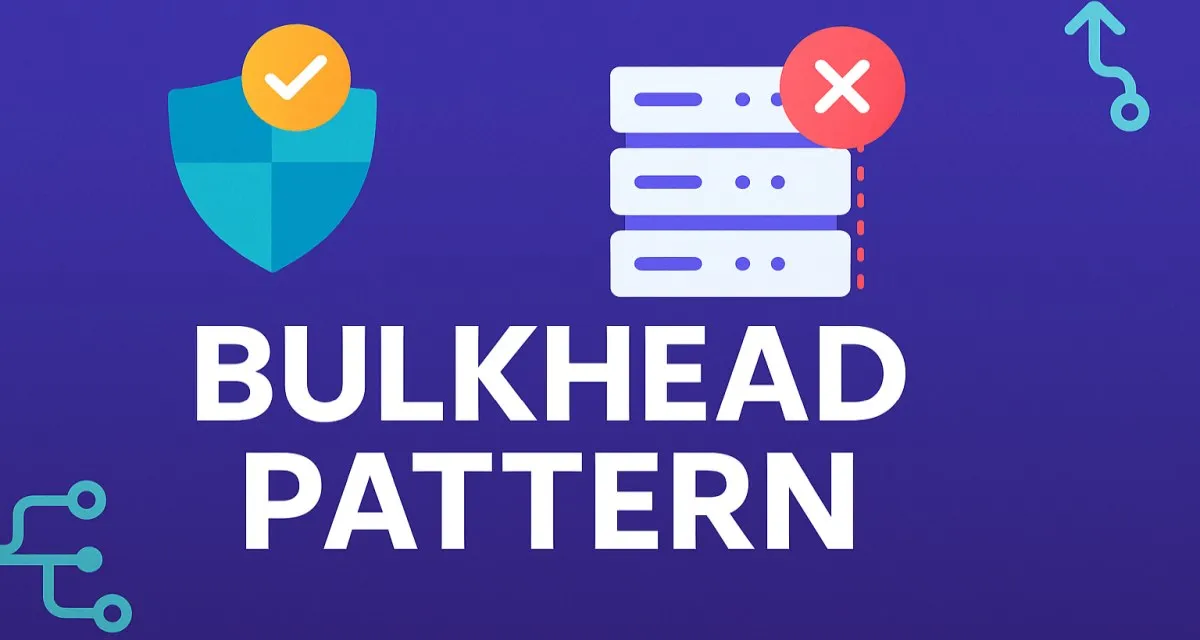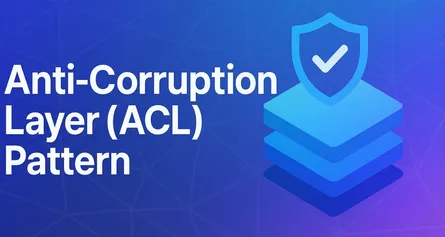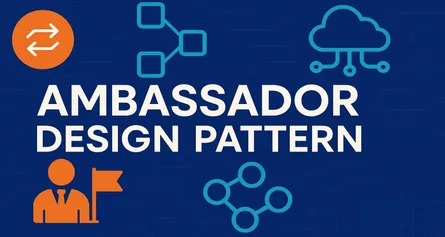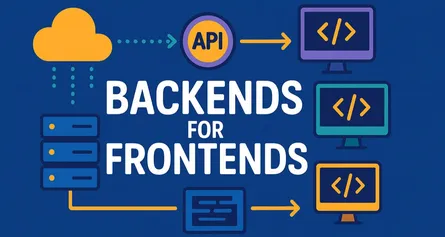
Comprehensive Guide to the Bulkhead Pattern: Ensuring Robust and Resilient Software Systems
- Sudhir mangla
- Cloud Design Patterns , Cloud architecture
- 15 May, 2025
As a software architect, have you ever faced situations where a minor hiccup in one part of your system cascades into a massive outage affecting your entire application? Have you wondered how cloud-based giants like Netflix, Amazon, or Google maintain their uptime and keep problems contained effectively? The answer often lies in robust architectural patterns like the Bulkhead pattern.
In this guide, we’ll delve deeply into the Bulkhead pattern, exploring its core concepts, best practices, strategic employment scenarios, and real-world C# code examples that you can directly apply in your software systems. By the end, you’ll have a crystal-clear understanding of how this pattern can enhance the resilience and stability of your applications.
1. Introduction to the Bulkhead Pattern
1.1 Definition: Isolating System Elements to Prevent Cascading Failures
The Bulkhead pattern is an architectural approach used to partition and isolate different system components so that failure in one component does not cascade and impact the entire system. It creates clear boundaries between components, managing resources effectively, and isolating failures to improve overall resilience.
1.2 Core Concept: Resource Segregation for Enhanced Stability
At its heart, the Bulkhead pattern revolves around dividing system resources (like threads, memory, connections, or CPU usage) into isolated compartments. Each compartment—or “bulkhead”—operates independently, ensuring that resource consumption or failures within one compartment don’t spill over into others.
1.3 Analogy: Learning from Naval Architecture (Ship Bulkheads)
Imagine a ship sailing across an ocean. A ship is built with watertight bulkheads—compartments designed to prevent water from flooding the entire vessel if one section is compromised. Similarly, in software, “bulkheads” prevent failure or resource exhaustion from overwhelming the whole system, ensuring smoother sailing in turbulent conditions.
1.4 Significance in Modern Architectures: Its Role as a Cloud Resiliency Pattern
Unlike traditional Gang of Four (GoF) patterns, Bulkhead isn’t primarily behavioral or structural in the conventional sense—it’s explicitly designed for resilience. With the advent of cloud-native and distributed systems, Bulkheads have emerged as essential for maintaining uptime, managing complex dependencies, and preventing system-wide outages.
1.5 Goals: What We Aim to Achieve with Bulkheads
When implementing the Bulkhead pattern, we aim to:
- Limit failure impact to isolated components.
- Prevent resource exhaustion from cascading through systems.
- Enable graceful degradation under extreme conditions.
- Ensure critical components maintain availability even when dependencies fail.
2. Core Principles of Bulkhead Implementation
Let’s explore key principles underlying effective bulkhead implementation:
2.1 Fault Isolation: Containing Failures Within Specific Components
The primary principle of the Bulkhead pattern is fault isolation. If one component fails, it shouldn’t cascade failures across your entire application. For instance, if an external payment gateway is slow, your product search or user registration features shouldn’t slow down or crash as a consequence.
2.2 Resource Limitation: Capping Resource Usage per Component or Service
Bulkheads limit resource allocation per component. For example, separate thread pools or connection pools dedicated to distinct parts of your application ensure that resource exhaustion in one area doesn’t compromise the entire system.
2.3 Preventing “Noisy Neighbor” Problems
A “noisy neighbor” occurs when one component excessively consumes resources, causing others to degrade. Bulkhead isolation ensures a misbehaving component doesn’t overwhelm shared resources, maintaining system-wide stability.
2.4 Load Shedding Enablement: Gracefully Degrading Service under Extreme Load
Bulkheads allow implementing load shedding, gracefully declining or deferring lower-priority requests during extreme load to preserve critical functionality. This maintains performance and reliability under peak demands.
3. Key Components and Concepts
Effective implementation of the Bulkhead pattern involves specific components and concepts:
3.1 Isolation Boundaries: Defining Compartments
Isolation boundaries clearly delineate system resources. Each boundary represents a discrete segment of your system, containing its dedicated resources and error handling mechanisms.
3.2 Resource Pools: Dedicated Resources
Common resources allocated via bulkheads include:
- Thread pools
- Connection pools
- Memory pools
Here’s a C# example illustrating dedicated thread pools using .NET 8 Tasks and dedicated schedulers:
// Custom scheduler for dedicated thread pools
var scheduler = new ConcurrentExclusiveSchedulerPair(TaskScheduler.Default, maxConcurrencyLevel: 5).ConcurrentScheduler;
// Bulkhead isolated task execution
Task.Factory.StartNew(async () =>
{
// Perform isolated work
await ProcessPaymentAsync(paymentRequest);
}, CancellationToken.None, TaskCreationOptions.None, scheduler);3.3 Concurrency Management: Semaphores and Locks
Semaphores or locks manage concurrent access, preventing resource exhaustion by limiting the number of simultaneous operations:
public class BulkheadService
{
private static readonly SemaphoreSlim _bulkheadSemaphore = new SemaphoreSlim(10); // Limit to 10 concurrent operations
public async Task ExecuteAsync(Func<Task> operation)
{
await _bulkheadSemaphore.WaitAsync();
try
{
await operation();
}
finally
{
_bulkheadSemaphore.Release();
}
}
}3.4 Queues: Buffering Requests for Bulkheaded Components
Queues buffer incoming requests, allowing controlled execution and resource management:
public class RequestQueue
{
private readonly Channel<Func<Task>> _channel = Channel.CreateBounded<Func<Task>>(new BoundedChannelOptions(50));
public RequestQueue()
{
Task.Run(ProcessQueueAsync);
}
public async Task EnqueueAsync(Func<Task> request)
{
await _channel.Writer.WriteAsync(request);
}
private async Task ProcessQueueAsync()
{
await foreach (var request in _channel.Reader.ReadAllAsync())
{
await request();
}
}
}3.5 Failure Handling & Fallbacks
Bulkheads facilitate graceful degradation through fallback strategies. When isolated components fail or timeout, a fallback mechanism ensures system stability:
public async Task<string> GetProductDetailsWithFallbackAsync(int productId)
{
try
{
return await ExternalProductService.GetDetailsAsync(productId);
}
catch (HttpRequestException)
{
// Fallback to cached response
return await CacheService.GetCachedProductDetailsAsync(productId);
}
}4. When to Strategically Employ the Bulkhead Pattern
Let’s identify scenarios where Bulkheads are strategically beneficial:
4.1 Identifying Critical vs. Non-Critical System Dependencies
Critical components (payments, user authentication) require stringent bulkhead isolation, whereas non-critical components (analytics, recommendations) may tolerate looser constraints.
4.2 Scenarios Prone to Resource Exhaustion
4.2.1 Interacting with External Services
External services can introduce latency or downtime, causing resource exhaustion. Bulkheads ensure isolated handling to prevent cascading delays.
4.2.2 Handling Different Types of User Requests
Segregating high-priority requests from background tasks prevents resource contention, ensuring responsive user experiences.
4.2.3 Processing Disparate Workloads
Bulkheads manage workloads with different resource profiles efficiently, preventing mutual interference.
4.3 Business Cases Driving Adoption
4.3.1 Ensuring High Availability for Revenue-Critical Features
Bulkheads protect revenue-critical functionalities like payments or checkout processes, preventing financial losses.
4.3.2 Meeting Service Level Agreements (SLAs)
Bulkheads help meet strict SLAs by isolating and managing critical services reliably.
4.4 Technical Contexts Where Bulkheads Shine
- Microservice Architectures: Maintain service independence and fault tolerance.
- Distributed Systems: Isolate failure to specific nodes or clusters.
- Systems with Multiple Third-Party Integrations: Manage unpredictable third-party latency or outages.
- Asynchronous Task Processing: Ensure background tasks don’t consume resources needed by user-facing processes.
5. Implementing the Bulkhead Pattern in C# and .NET
Translating the Bulkhead pattern from architectural principle to practical implementation requires thoughtful use of C# and .NET capabilities. Let’s examine the core strategies, practical code samples, and observability best practices to equip your system for real-world resilience.
5.1 Fundamental Implementation Strategies
5.1.1 Thread Pool Segregation
One of the most effective ways to implement a software bulkhead is by isolating work using dedicated thread pools. By separating workloads, you prevent resource contention between unrelated parts of your system.
5.1.1.1 Using Dedicated TaskScheduler Instances
C# provides the flexibility to create custom TaskScheduler instances, allowing you to partition CPU resources. This is especially useful when you need to isolate CPU-intensive, I/O-bound, or latency-sensitive operations from one another.
Example:
// Segregated scheduler for bulkheaded operations
var scheduler = new ConcurrentExclusiveSchedulerPair(TaskScheduler.Default, maxConcurrencyLevel: 5).ConcurrentScheduler;
for (int i = 0; i < 10; i++)
{
Task.Factory.StartNew(() =>
{
// Isolated processing logic here
Console.WriteLine($"Task {Task.CurrentId} is running on a dedicated scheduler.");
}, CancellationToken.None, TaskCreationOptions.None, scheduler);
}5.1.1.2 Custom Thread Pool Implementations (and Why to Be Cautious)
While it’s technically possible to roll your own thread pool using Thread or Task APIs, it’s rarely recommended unless you have unique requirements. .NET’s built-in thread pool is highly optimized for most scenarios. Custom implementations risk subtle bugs, deadlocks, and poor resource management.
5.1.1.3 C# Example: Basic Thread Pool Isolation for Different Task Types
Imagine separating “critical” and “background” workloads, each with its own concurrency cap.
var criticalScheduler = new ConcurrentExclusiveSchedulerPair(TaskScheduler.Default, 3).ConcurrentScheduler;
var backgroundScheduler = new ConcurrentExclusiveSchedulerPair(TaskScheduler.Default, 2).ConcurrentScheduler;
// Critical tasks
Task.Factory.StartNew(() => ProcessCriticalOperation(), CancellationToken.None, TaskCreationOptions.None, criticalScheduler);
// Background tasks
Task.Factory.StartNew(() => ProcessBackgroundOperation(), CancellationToken.None, TaskCreationOptions.None, backgroundScheduler);5.1.2 Connection Pooling per Dependency
When your application talks to external services or databases, isolating connection pools ensures that a spike or failure in one area does not saturate your entire pool, thereby impacting unrelated features.
5.1.2.1 Configuring HttpClientFactory for Distinct Downstream Services
With IHttpClientFactory in ASP.NET Core, you can configure named or typed clients. Each can have its own handler lifetime and connection pool, providing isolation between, for example, payment and notification services.
Example:
services.AddHttpClient("PaymentService", client =>
{
client.BaseAddress = new Uri("https://api.payments.example");
}).SetHandlerLifetime(TimeSpan.FromMinutes(5));
services.AddHttpClient("NotificationService", client =>
{
client.BaseAddress = new Uri("https://api.notifications.example");
}).SetHandlerLifetime(TimeSpan.FromMinutes(2));5.1.2.2 Database Connection String Configurations for Pool Isolation
For databases, pool segregation is achieved by using distinct connection strings and sometimes even separate user identities, ensuring isolation at the database driver level.
// Two separate EF Core DbContexts with isolated connection pools
services.AddDbContext<PaymentsDbContext>(options =>
options.UseSqlServer(Configuration.GetConnectionString("PaymentsDB")));
services.AddDbContext<ReportingDbContext>(options =>
options.UseSqlServer(Configuration.GetConnectionString("ReportingDB")));5.1.2.3 C# Example: HttpClientFactory Setup for Isolated Service Clients
public class PaymentClient
{
private readonly HttpClient _httpClient;
public PaymentClient(IHttpClientFactory factory)
{
_httpClient = factory.CreateClient("PaymentService");
}
public async Task<bool> ProcessPaymentAsync(PaymentRequest request)
{
// Logic using _httpClient
}
}5.1.3 Concurrency Limiting with SemaphoreSlim
A tried-and-true pattern in C# is to use SemaphoreSlim to guard resource-intensive operations. This gives you granular control over the number of concurrent executions.
5.1.3.1 Protecting Resource-Intensive Operations
Wrap calls to external dependencies, disk I/O, or CPU-heavy work with a semaphore.
5.1.3.2 Implementing Asynchronous Waits
SemaphoreSlim supports asynchronous waits with WaitAsync, ensuring non-blocking usage.
5.1.3.3 C# Example: Using SemaphoreSlim to Limit Concurrent Calls to a Service
public class BulkheadLimiter
{
private readonly SemaphoreSlim _semaphore;
public BulkheadLimiter(int maxConcurrency)
{
_semaphore = new SemaphoreSlim(maxConcurrency, maxConcurrency);
}
public async Task<TResult> ExecuteAsync<TResult>(Func<Task<TResult>> action)
{
await _semaphore.WaitAsync();
try
{
return await action();
}
finally
{
_semaphore.Release();
}
}
}5.2 Leveraging Modern .NET Libraries and Features
5.2.1 Polly for Robust Bulkhead Policies
Polly is a de-facto standard for resiliency in .NET. Its BulkheadPolicy lets you cap the number of concurrent actions and optionally queue excess requests.
5.2.1.1 Defining BulkheadPolicy and BulkheadRejectedException
A BulkheadPolicy blocks further calls when the concurrency limit is reached, throwing BulkheadRejectedException.
5.2.1.2 Combining Bulkhead with Retry, Circuit Breaker, and Timeout Policies
Resilience increases when bulkhead is composed with other policies. For example, you may want to retry on transient errors, trip a circuit breaker on persistent failures, or time out long-running operations.
5.2.1.3 C# Example: Integrating Polly’s BulkheadPolicy in an ASP.NET Core Service Client
var bulkheadPolicy = Policy
.BulkheadAsync<HttpResponseMessage>(maxParallelization: 5, maxQueuingActions: 10,
onBulkheadRejectedAsync: context =>
{
// Optionally log or track
return Task.CompletedTask;
});
var retryPolicy = Policy
.Handle<HttpRequestException>()
.RetryAsync(3);
var policyWrap = Policy.WrapAsync(bulkheadPolicy, retryPolicy);
public async Task<HttpResponseMessage> CallExternalServiceAsync(HttpClient client)
{
return await policyWrap.ExecuteAsync(() => client.GetAsync("api/data"));
}5.2.2 Asynchronous Bulkheads with async/await and Channel
With Channel<T>, you can implement an efficient producer/consumer queue that acts as a bulkhead, decoupling request intake from processing and smoothing out spikes.
5.2.2.1 Managing Work Queues and Worker Tasks
A bounded channel lets you buffer requests. Worker tasks then pull from the channel, each isolated by their concurrency cap.
5.2.2.2 Decoupling Request Submission from Processing
Requesters enqueue work without blocking, and a fixed pool of workers consumes it, keeping processing within safe resource bounds.
5.2.2.3 C# Example: Producer/Consumer Pattern with Channel as Bulkhead
public class BulkheadQueue<T>
{
private readonly Channel<T> _channel;
private readonly List<Task> _workers;
public BulkheadQueue(int maxWorkers, int queueCapacity, Func<T, Task> process)
{
_channel = Channel.CreateBounded<T>(queueCapacity);
_workers = Enumerable.Range(0, maxWorkers)
.Select(_ => Task.Run(async () =>
{
await foreach (var item in _channel.Reader.ReadAllAsync())
{
await process(item);
}
}))
.ToList();
}
public async Task EnqueueAsync(T item)
{
await _channel.Writer.WriteAsync(item);
}
}5.2.3 Process-Level Isolation (Advanced)
Some problems cannot be isolated within a single process. Process-level isolation—especially via containers or actor-based frameworks—provides the strongest form of bulkhead.
5.2.3.1 Considerations for Containerization (e.g., Docker, Kubernetes)
Containers give you OS-level resource control. Assign CPU, memory, and network quotas per service. Kubernetes even offers pod-level resource limits and autoscaling, providing bulkhead-like isolation across the cluster.
5.2.3.2 Brief Mention of Actor Frameworks (Orleans, Akka.NET)
Actor frameworks encapsulate state and execution per actor. Each actor’s processing is isolated, failures are localized, and workloads are naturally partitioned. Orleans, Akka.NET, and Service Fabric Reliable Actors are worth exploring for high-scale isolation.
5.3 Configuration and Dynamic Adjustments
Static limits can become bottlenecks or insufficient as system usage patterns shift. Dynamic adjustment—driven by configuration or operational signals—enables adaptive bulkheading.
5.3.1 Externalizing Bulkhead Parameters via IConfiguration
Configuration providers in .NET (IConfiguration) allow for externalizing pool sizes, queue lengths, and timeouts, so changes can be made without code redeployment.
public class BulkheadOptions
{
public int MaxConcurrentRequests { get; set; }
public int QueueCapacity { get; set; }
}
services.Configure<BulkheadOptions>(Configuration.GetSection("Bulkhead"));5.3.2 Strategies for Dynamic Resizing
Adjusting pool sizes on the fly is complex—doing so can introduce race conditions or state corruption if not carefully managed. Where possible, changes should be coordinated and rolled out gradually, with observability in place.
5.3.3 Using Feature Flags or Configuration Providers for Adaptive Behavior
Feature flags let you selectively enable new bulkhead settings for subsets of traffic or users. This allows for safe experimentation and rollback.
if (_featureManager.IsEnabled("IncreaseBulkheadSize"))
{
bulkheadPolicy = Policy.BulkheadAsync<HttpResponseMessage>(10, 20);
}
else
{
bulkheadPolicy = Policy.BulkheadAsync<HttpResponseMessage>(5, 10);
}5.4 Observability: Monitoring Bulkhead Health in .NET
Isolation is only effective if you can measure its efficacy and respond to problems in real time. Comprehensive observability is therefore non-negotiable.
5.4.1 Key Metrics to Track with System.Diagnostics.Metrics or AppInsights
Modern .NET offers powerful built-in metrics via System.Diagnostics.Metrics (OpenTelemetry) and seamless integration with Application Insights.
5.4.1.1 Queue Lengths per Bulkhead
How many requests are waiting in each queue? Sudden increases can indicate downstream slowness or underprovisioned resources.
5.4.1.2 Number of Active Resources/Tasks in a Bulkhead
Track how many threads or requests are actively being processed within each bulkhead.
5.4.1.3 Rejection Rates (e.g., BulkheadRejectedException Occurrences)
How often are requests rejected due to full bulkheads? A spike in rejections often signals an overload or misconfiguration.
5.4.1.4 Latency Within and Through Bulkheads
Measure response times both within the bulkhead and end-to-end. Increases in bulkhead-internal latency may point to resource contention or downstream problems.
C# Metric Example:
var meter = new Meter("BulkheadMetrics", "1.0");
var activeTasks = meter.CreateObservableGauge("bulkhead_active_tasks", () => GetActiveTaskCount());
var queueLength = meter.CreateObservableGauge("bulkhead_queue_length", () => GetQueueLength());5.4.2 Structured Logging for Bulkhead Events
Structured logs (using Serilog, NLog, or built-in logging in ASP.NET Core) provide context-rich insights for bulkhead-related events:
- Entry and exit from bulkheads
- Rejections (with reasons)
- Failures and fallback activations
_logger.LogInformation("Bulkhead entered: {Operation}", operationName);
_logger.LogWarning("Bulkhead rejected request: {Reason}", reason);5.4.3 Alerting on Threshold Breaches or High Rejection Rates
Tie your observability into alerting platforms—like Azure Monitor, PagerDuty, or Grafana—so that teams are instantly notified when bulkheads begin rejecting at abnormal rates or when latencies breach defined thresholds.
6. Real-World Use Cases and Architectural Scenarios
Understanding real-world scenarios is crucial to effectively implementing the Bulkhead pattern. Let’s explore common practical cases where Bulkhead isolation provides clear and measurable benefits.
6.1 Isolating Calls to Different Downstream Microservices in an E-commerce Platform
Imagine an e-commerce platform with multiple microservices handling different business functionalities like product catalog, payments, recommendations, shipping, and notifications. Each service has distinct latency characteristics and failure modes. Without isolation, a slowdown in payments could degrade product search performance.
By isolating each downstream microservice call behind dedicated HttpClients or Polly Bulkheads, you maintain overall system responsiveness and protect user experience, even if a single dependency is degraded.
Example Scenario in C#:
// Bulkhead-per-service in ASP.NET Core with Polly
services.AddHttpClient("PaymentsAPI")
.AddPolicyHandler(Policy.BulkheadAsync<HttpResponseMessage>(10, 20));
services.AddHttpClient("RecommendationsAPI")
.AddPolicyHandler(Policy.BulkheadAsync<HttpResponseMessage>(5, 10));6.2 Protecting Database Access by Segregating Read and Write Operations or Tenant Data Access
Separating database workloads into read-only and read-write pools ensures that heavy reporting queries do not degrade critical transactional operations. This approach is especially valuable in multi-tenant architectures, isolating tenants with distinct resource pools.
Example Configuration in .NET:
// DbContext segregation by read-write concerns
services.AddDbContext<TransactionalContext>(opts => opts.UseSqlServer(Configuration["ConnectionStrings:TransactionalDB"]));
services.AddDbContext<ReportingContext>(opts => opts.UseSqlServer(Configuration["ConnectionStrings:ReportingDB"]));6.3 Segregating User Tiers (e.g., Free vs. Premium Users) to Guarantee Resources for Paying Customers
Bulkheads can enforce resource guarantees for paying customers. If free-tier users create bursts of traffic, isolation ensures premium customers always experience smooth performance. Consider separate task schedulers, request queues, or concurrency limits.
Example:
// Premium users have higher concurrency limits
var premiumUserSemaphore = new SemaphoreSlim(50);
var freeUserSemaphore = new SemaphoreSlim(10);6.4 Isolating Resource-Intensive Background Jobs from Real-Time APIs
Real-time APIs must remain responsive. CPU-intensive or I/O-heavy tasks like report generation, video transcoding, or large batch processing should run on isolated schedulers or processes. Bulkheads protect real-time responsiveness.
Example using TaskScheduler Isolation:
var realTimeScheduler = new ConcurrentExclusiveSchedulerPair(TaskScheduler.Default, 20).ConcurrentScheduler;
var backgroundScheduler = new ConcurrentExclusiveSchedulerPair(TaskScheduler.Default, 2).ConcurrentScheduler;
Task.Factory.StartNew(ProcessRealTimeRequests, CancellationToken.None, TaskCreationOptions.None, realTimeScheduler);
Task.Factory.StartNew(ProcessBackgroundJobs, CancellationToken.None, TaskCreationOptions.None, backgroundScheduler);6.5 Handling Messages from Different Queues with Dedicated Consumer Pools
Message-driven architectures can benefit from dedicated consumer pools per message type. Bulkheading message consumption ensures predictable throughput for critical message types.
Example with Channels and Consumer Pools:
var highPriorityQueue = Channel.CreateBounded<Message>(capacity: 100);
var lowPriorityQueue = Channel.CreateBounded<Message>(capacity: 50);
// Separate consumers per queue
Task.Run(() => ConsumeMessages(highPriorityQueue.Reader, maxConcurrency: 10));
Task.Run(() => ConsumeMessages(lowPriorityQueue.Reader, maxConcurrency: 3));7. Common Anti-Patterns and Pitfalls to Avoid
Implementing bulkheads effectively requires awareness of common pitfalls.
7.1 Overly Granular Bulkheads
Too many small bulkheads increase complexity, cause resource fragmentation, and operational overhead. Focus on meaningful isolation boundaries.
7.2 Incorrect Sizing of Resource Pools
Under-provisioning leads to throttling and rejects valid requests. Over-provisioning wastes resources. Continual tuning and monitoring are essential.
7.3 Ignoring Inter-dependencies
Serial dependencies between bulkheads without proper timeouts lead to cascading waits and degrade performance significantly. Bulkhead isolation works best when coupled with timeout policies.
7.4 Lack of Monitoring and Alerting
If you don’t monitor, you’re effectively blind to bulkhead performance and rejections. Monitoring and alerting are critical for effective operational management.
7.5 Static Configuration in Highly Dynamic Environments
Static limits may become obsolete as traffic patterns evolve. Ensure that your configurations can be dynamically adjusted as workloads change.
7.6 Shared Queues for Dissimilar Workloads
Placing unrelated workloads in a shared queue negates the benefits of isolation. Segregate tasks based on resource usage and priority.
7.7 Not Implementing Fallback Strategies
Failing to define fallbacks for rejected or failed requests leads to poor user experience. Always provide graceful degradation.
8. Advantages and Benefits of the Bulkhead Pattern
The Bulkhead pattern significantly enhances your architecture’s reliability and performance.
8.1 Enhanced System Stability and Resilience
Bulkheads isolate and contain faults, preventing system-wide outages. Each compartment acts independently, improving resilience.
8.2 Prevention of Cascading Failures
Isolated resource pools prevent failure in one area from affecting unrelated services or features.
8.3 Improved Fault Isolation
Isolation boundaries make diagnosing and resolving issues simpler and faster. You know exactly where the fault originated.
8.4 Predictable Performance for Isolated Components
With defined resource boundaries, each component achieves predictable performance, ensuring SLAs and user satisfaction.
8.5 Increased Availability for Critical System Functions
Critical functions remain operational even under extreme load, protecting business-critical transactions and services.
8.6 Fair Resource Allocation Among Services
Bulkheads ensure fair and predictable allocation, preventing “noisy neighbors” from starving important services of resources.
9. Disadvantages and Limitations to Consider
While powerful, bulkheads introduce complexity.
9.1 Increased Architectural and Implementation Complexity
Bulkheads increase system complexity, requiring more detailed planning and careful execution.
9.2 Potential for Resource Fragmentation
Poorly managed bulkheads can lead to under-utilization or inefficient resource distribution.
9.3 Overhead of Managing Multiple Resource Pools
Each pool requires oversight, monitoring, and adjustment. This adds operational overhead.
9.4 Difficulty in Determining Optimal Configuration Parameters
Finding the right pool sizes, queue lengths, and concurrency limits requires experimentation, monitoring, and iterative adjustment.
9.5 Can Introduce Latency
If resources become contended or queues overflow, additional latency may impact response times negatively.
10. Conclusion and Best Practices for .NET Architects
Bulkhead patterns are vital for robust, resilient .NET applications. Here are essential practices for effective implementation:
10.1 Recap: Bulkhead as a Cornerstone of Resilient Systems
Bulkheads are indispensable in modern distributed architectures, providing isolation, resilience, and stability.
10.2 Key Considerations for Effective Implementation
Carefully define isolation boundaries, use modern libraries (Polly, Channels), and leverage observability tools for effectiveness.
10.3 Start Simple, Monitor, and Iterate
Implement incrementally, monitor closely, and refine your configurations based on observed data.
10.4 Combine Wisely
Bulkheads complement patterns like Retry, Circuit Breaker, Timeouts, and Rate Limiting. Use them together effectively.
10.5 Prioritize Observability
Measure, log, and alert aggressively to understand bulkhead behavior and proactively respond.
10.6 Automate Testing
Create automated tests simulating failure and stress conditions. Verify your bulkheads perform as expected under load.
10.7 The Future: Evolving Resilience Approaches
Stay attuned to emerging resilience techniques such as service meshes (Istio, Linkerd), enhanced Kubernetes isolation, and advanced .NET integrations (Orleans, YARP).
By carefully considering and implementing these best practices, you’ll empower your .NET systems to gracefully handle challenges, scaling confidently with user growth and business demands.





